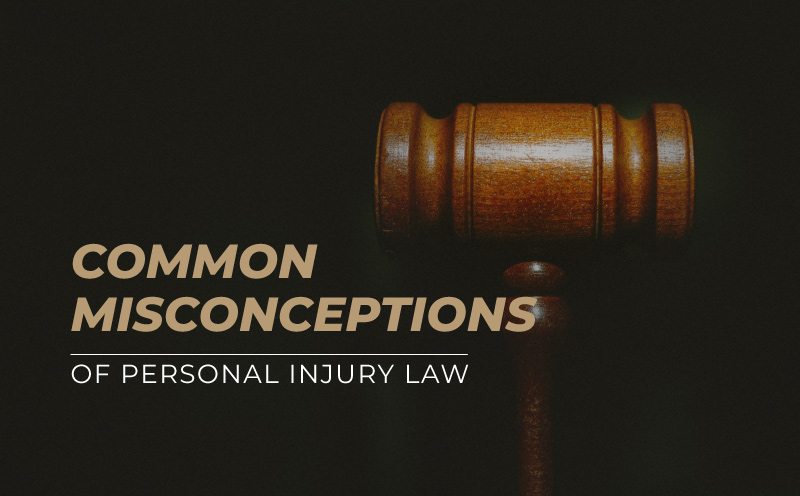Personal Injury Misconceptions – How the Legal System Works When Injured Because of Another

You’ve been injured. Whether your injuries are a result of being in a car crash, a dog attack, or any other form of harm caused by the negligence of another person or entity, you’re now wondering if you have any legal options. But the legal system is confusing and complex, and there are many personal injury misconceptions out there. Understanding personal injury law and what your rights may be if you’ve been injured because of another person cannot be overstated. In this article, we explore the common misconceptions surrounding personal injury cases, what the first steps are in pursuing a personal injury claim, how personal injury claims work, and much more.
Biggest Personal Injury Misconception: I’ve been injured, I have an automatic right to bring a lawsuit
During an appearance on WLAJ 53 “In the Name of the Law”, Lansing personal injury attorney, Steve Sinas, discussed the many misconceptions he sees while speaking to people about potential cases. First and foremost, the biggest misunderstanding Steve encounters is peoples’ belief that, just because they were hurt, they automatically have the right to bring a lawsuit against the possible offending party and recover money.
“There are no universal rights that we have to bring personal injury cases,” said Sinas. “Every injury must be examined by its own unique facts and circumstances to determine what extent the person has legal right to pursue.”
A different set of rules governs each area of personal injury, whether it’s an auto accident, hazardous property condition, medical malpractice, or wrongdoing by the government. One aspect governed by these sets of rules is pursuing compensation from the appropriate party in particular areas of personal injury law. And unfortunately, sometimes, there is no defendant to pursue compensation from.
Personal Injury Misconception: I will have to appear in court
Many people believe that bringing a lawsuit against the at-fault party means they will have to appear in court. This isn’t necessarily true in all cases. Once your personal injury attorney has closely examined all the facts of your potential case and determined you have the right to pursue a personal injury claim, they must then decide what is the best course of action and steps to pursue that claim.
Those steps include:
- Assessing whether there is insurance available from the at-fault party.
- If the responsible party does have insurance, contacting the insurance company and communicating whether or not a resolution can be made may be in the injured person’s best interest.
- If a resolution cannot be agreed upon with the opposing party’s insurance provider, your attorney may advise initiating a lawsuit.
Before an injured person may have to appear in court during their personal injury lawsuit, a lengthy process takes place. As the first step following the filing of a lawsuit, the court must issue a scheduling order. Included in that order you will find a timeline outlining how the case will be litigated. Parts of that timeline include witness disclosures, documents and evidence disclosures, motion deadlines, and settlement negotiations. In most cases, a lawsuit never makes it to that point, as these cases often reach a settlement beforehand. If a trial were to take place, it could be a year from the filing date before the case makes it to the courtroom. At that point, you would need to start showing up to court on a regular basis.
Personal Injury Misconception: I can file a lawsuit at any time
Any legal action has an applicable statute of limitation. This means that depending on the case, the injured person must take legal action during a certain period from the incident, or they will lose the right to pursue a claim.
You can learn more about a variety of personal injury statutes of limitations here or listed below:
Common Personal Injury Misconception: I am guaranteed the compensation determined by the jury
Once a verdict is rendered, the final amount the injured party may receive goes back to where that compensation will come from: AKA the at-fault party’s liability insurance or personal funds. In some instances, the limit on the at-fault party’s insurance policy may only cover some of the awarded verdict. For instance, if a jury awards an injured person $100,000, but the at-fault party chose a liability limit of $50,000 this could result in the injured person not receiving the full verdict. In these situations, whether or not the at-fault party’s assets can be recovered to recoup the remaining verdict amount comes into play. In instances where the at-fault party has no other meaningful assets, there may not be any other avenues the injured party may pursue to recoup that lost verdict amount.
Common Personal Injury Misconception: I am the injured party, I will automatically win my personal injury case
Unfortunately, not all cases result in an automatic win for the injured person due to a variety of factors surrounding that case. At the end of the day, should your personal injury claim go to trial, a jury will decide if the at-fault party is liable. In instances where the jury finds the at-fault party liable, the jury must then assign a monetary amount the injured party receives.
Main Take Away – Finding the Right Personal Injury Representation
Many people have various misconceptions regarding personal injury law. For those injured and considering pursuing a lawsuit against the at-fault party, the specific personal injury process is important to understand. Be sure to speak with a qualified and experienced Michigan personal injury attorney early on in your research to understand the steps, demystify any areas of personal injury law you may have, and fully understand the potential process ahead of you. If you’re searching for the best Michigan personal injury attorney, we recommend looking at their firm’s settlements and verdicts to ensure they are willing to go the extra mile to obtain the compensation you will need to aid in your healing journey. Additionally, an attorney’s record of verdicts signals he or she is willing to do everything it takes to represent you to the full extent and an unwillingness to compromise with a settlement. Look also for a firm with a track record of success representing injured people with similar cases and a thorough knowledge of that particular case law. If ever in doubt and you still have questions about personal injury law, always go with the attorney that is willing to help you better understand how personal injury law works and explain these common personal injury misconceptions.

